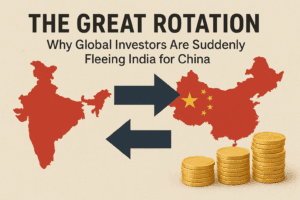The Great Rotation: Why Global Investors Are Suddenly Fleeing India for China
A dramatic reversal of fortune is underway in emerging markets, with investors executing a sharp pivot away from India and toward North Asia. India-focused funds have bled $1.8 billion in their steepest outflow in eight months, signaling a potent shift in sentiment. This exodus is primarily driven by India’s premium valuations, which left the market vulnerable to profit-taking. Concurrently, China and Hong Kong funds have attracted a combined $7.5 billion, as their deeply discounted markets present a compelling contrarian opportunity.
The political shock of the recent U.S. presidential election has further accelerated this rotation, introducing new trade policy uncertainties. This move highlights the fickle nature of global capital, which constantly seeks the most advantageous risk-reward balance. For India, this outflow tests the resilience of its growing domestic investor base, which must now counterbalance foreign selling. Ultimately, this is a tactical reallocation based on short-term factors, not a verdict on India’s long-term structural growth narrative.

The Great Rotation: Why Global Investors Are Suddenly Fleeing India for China
A dramatic shift is underway in global emerging markets, upending the investment trends that dominated for nearly two years. In a stunning reversal, foreign capital is flowing out of India at its fastest pace in eight months while flooding into China and Hong Kong. This isn’t just a routine market fluctuation; it’s a significant rotation that speaks volumes about changing investor psychology, valuation realities, and the powerful impact of global political tides.
According to a report by Elara Capital highlighted by Business Standard, India-focused equity funds witnessed a staggering $1.8 billion in outflows over the past four weeks. Meanwhile, China and Hong Kong funds attracted a combined $7.5 billion, signaling a clear and forceful pivot in investor preference toward North Asia.
So, what’s driving this sudden exodus from the world’s fastest-growing major economy?
Beyond the Headlines: The Real Drivers of the Shift
While the numbers are stark, the reasons behind them are a complex cocktail of factors:
- The Valuation Reckoning: For months, analysts have warned that Indian equity markets were priced to perfection. Sky-high valuations left little room for error. When a market is that expensive, any hint of negative news or an uncertain outlook can trigger a sharp correction. Investors are now taking profits from a market that has delivered stellar returns and moving to where they see better value—and China, beaten down by a prolonged property crisis and economic slowdown, represents the ultimate value play.
- The “Trump Trade” Resurgence: The news snippet hints at a crucial catalyst: the U.S. presidential victory of Donald Trump. His proposed policies, particularly aggressive tariffs on imports, create significant uncertainty for export-dependent economies. India, with its growing manufacturing ambitions and IT services sector, is seen as potentially vulnerable. Conversely, a potential de-escalation of the U.S.-China trade war under Trump (a possibility some traders are betting on) could provide immediate relief to Chinese markets, making them an attractive, contrarian bet.
- The Simple Allure of Contrarianism: Investing is often about buying low and selling high. After a prolonged bull run in India and a protracted bear market in China, a tactical rotation is a classic fund manager move. The flow into China is less a vote of confidence in its immediate economic health and more a bet on a short-term rebound from deeply oversold conditions. It’s a game of mean reversion.
What This Means for the Indian Investor
For domestic investors, this outflow can feel unsettling. Headlines about foreign institutional investors (FIIs) pulling out billions often lead to short-term volatility and market dips. However, it’s critical to view this with a long-term perspective:
- A Test of Domestic Resilience: This outflow tests the strength of India’s local investor base. The rise of systematic investment plans (SIPs) and robust domestic institutional investor (DII) participation has created a powerful counterbalance to foreign money. A market supported by its own citizens is a more mature and stable market.
- A Healthy Correction? A sell-off can wash out excess speculation, compress valuations to more reasonable levels, and create attractive entry points for long-term investors focused on India’s structural growth story—urbanization, digitalization, and manufacturing growth.
- Focus on Fundamentals: This rotation is a stark reminder that global capital is fickle and moves quickly. It underscores the importance of basing investment decisions on company fundamentals—strong balance sheets, good governance, and sustainable growth—rather than chasing momentum or relying on perpetual foreign inflows.
The current $1.8 billion outflow is a significant event, but it’s likely more of a tactical shift than a strategic abandonment of India. Global fund managers are reallocating capital based on short-term valuations, geopolitical bets, and the search for contrarian opportunities.
For India, the challenge is to continue strengthening its domestic economic foundations to make its growth story less susceptible to the whims of global capital. For investors, the lesson is to stay disciplined, avoid panic, and remember that while international money can amplify market moves, the true engine of Indian equity growth remains at home.
The “China vs. India” investment debate is far from settled. This rotation is merely the next chapter, not the final word.
You must be logged in to post a comment.